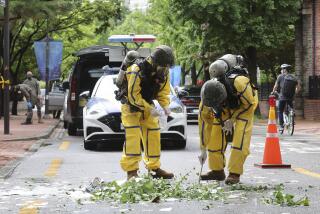There Is Nothing Like the DMZ to Give These Games Perspective
- Share via
PANMUNJOM, Korea — “The visit to the Joint Security Area at Panmunjom will entail entry into a hostile area and possibility of injury or death as a direct result of enemy action . . . . Although incidents are not anticipated, the United Nations Command, the United States of America and the Republic of Korea cannot guarantee the safety of visitors and cannot be held accountable in the event of a hostile enemy act.”
--From a release form to be signed by visitors to the Korean DMZ.
This being the Olympics, and the Olympics being about games, how could I pass up a chance to see the most interesting games venue in Korea?
I sign up for a press tour to Panmunjom, a journey to the border line where North Korea meets South Korea with icy stares and dueling loudspeakers.
Don’t tell me this isn’t a game. I’m about to encounter the best athletes I’ll see for two weeks. Everybody keeps score, and the tour guide shows you stop-action replays--of a machete murder.
Traveling north from Seoul, our bus rolls through lush, green countryside, rice fields stretching out into rolling hills, to jagged mountains in the distance. It’s a 32-mile ride to the DMZ, the demilitarized zone. As the saying here goes: Ninety minutes by bus, seven seconds by missile.
About 10 miles south of the DMZ we begin to see fence-like rows of concrete stumps stretched across the rice fields every few miles. These are tank traps, in case the North Koreans decide to pay a surprise visit to Seoul.
We are on our way to the 38th parallel, where the 151-mile-long demilitarized zone has divided North and South Korea since the Korean War armistice of 1953.
I don’t know why they call this a demilitarized zone, since about a million combat-primed soldiers stand guard along either side. I’d hate to see a militarized zone.
In the middle of the DMZ is our destination, the so-called truce village of Panmunjom. It is little more than a clump of plain buildings where leaders of the North and South meet almost daily to argue about various breaches of the ’53 armistice agreement that divided Korea into snarling Siamese twins, joined at the DMZ.
The North’s goal is to rid South Korea of U.S. influence and unite the countries under Communist rule, by force if need be. The South’s goal is to thwart the North. Thus the game.
In Panmunjom, the game is played out in many forms:
--Chest puffing. The 200 U.S. Army soldiers stationed at Camp Bonifas, a few hundred yards from Panmunjom, are big beef, the better to intimidate the North Koreans. Men--there are no women here--under 6 feet and lacking some heft are not invited to serve the one-year voluntary tour of duty. The 150 or so South Korean soldiers must be martial arts black belts.
The North Korean soldiers, with our troops watching through binoculars, counter this show of force by splitting trees with martial-arts finesse, and with goose-step marching drills, the sun glinting off the nails sticking out of their boots. Ty Cobb would understand.
--Flag waving. The South Koreans erected an Eiffel tower-like flagpole, 100 meters high, in the nearby farming village, and ran up a huge South Korean flag.
So the North Koreans erected their own eye-full tower on the opposite bank of the little Sachon River. Their flag pole is 160 meters high, and they fly a flag big enough to tent a two-story home.
--Battling bands. In the middle of a ginseng field, the North planted a pole topped by a huge speaker system. They broadcast a constant stream of strident military music and anti-U.S. propaganda.
So the South Koreans installed a similar sound system on their side of the river, and the battling propaganda echoes and rolls with an eerie, tinny din through the hills and valleys. For variety, the South Koreans sometimes throw in some American rock ‘n’ roll.
--Hold that line. The North Koreans dig secret tunnels under the hills, under the DMZ border line, through which to launch a surprise attack on Seoul.
Our troops send out tunnel detection teams. Our last find was 10 years ago, but we suspect the other guys are still digging.
In the south end of the discovered tunnels, we keep birds in cages, as early detectors of any deadly gas the Northerners might send our way. Bird dies, our guys get out fast.
--Scouting. Our troops keep the North under constant photo and eyeball surveillance. Likewise, when civilians come north from Seoul to tour the DMZ, we are warned that we will be photographed by the North Koreans for propaganda purposes. We are instructed not to gesture or even point.
We must abide by a dress code--no jeans, athletic shoes, T-shirts or miniskirts--because the U.N. demands we present a positive image to the North.
This is not your typical military installation. The enemy is a few paces away. There is no fence separating North and South in the Panmunjom compound, only two parallel rows of white stakes, like golf out-of-bounds markers.
It is said that the North Koreans are extra cranky these days. Their hated neighbors to the South are hosts of a wonderful international event, are being toasted and legitimized by the world, while North Korea can only peer enviously over the back fence.
It is also reported that the North Koreans have pledged not to disrupt the Olympic Games, out of respect to the North’s Soviet Union pals. Still, as a Navy commander stationed here said, “What we consider normal logic just doesn’t apply to the North Koreans. We really don’t know what we’re dealing with.”
Someone asks our tour guide, a sergeant who looks like Steve Sax’s linebacker brother, if the Olympics in Seoul have brought added tension to the DMZ.
“No,” he says firmly. “This unit’s always on full alert.”
Indeed, one crack quick-reaction team here eats and reads at night by infrared light so their eyes will immediately adjust to darkness if they are summoned to duty. They sleep with their combat fatigues and boots on, weapons loaded.
The U.S. soldiers arrive here big and tough, and get bigger and tougher. They are encouraged to lift weights and run and compete, and many of them finish their year-long tour here honed as fine as decathletes.
There are no Gomer Pyles. U.S. soldiers are also selected on the basis of clean records and intelligence, because quick thinking may be required.
Four years ago, a Russian tourist bolted his party and dashed across the DMZ line. North Korean guards gave chase, firing automatic weapons, and in the ensuing battle, right here where our tour takes us today, three North Koreans were killed and five injured. One South Korean soldier was killed and one U.S. soldier wounded.
And 12 years ago, in the area just behind us, a detail of Americans and South Koreans was sent to prune a poplar tree that interfered with U.S. surveillance of the area. The detail was attacked by North Koreans wielding long-bladed axes. They hacked two U.S. officers to death.
Our tour guide shows us photos of the gruesome event. Sometimes the games here get very intense. So it is that among the steely-eyed, rock-jawed U.S. soldiers, there is what our guide terms “a more heightened awareness.”
Not that there’s not time for fun and games. There are a basketball court, tennis court, soccer field, swimming pool, six weight rooms, jogging trails through the fields. A little snow, monsoon rains or oppressive heat never slow down this year-round training.
There is even a one-hole golf course, but you don’t chase your shots out of bounds because the area is heavily mined.
Our tour takes us to a hilltop observation post. On a guard tower about 200 yards to the north, a North Korean soldier quickly scampers out of his hut and sets up a camera tripod to record my visit to the DMZ. I shoot back.
Soon we bid goodby to the ever-ready soldiers of the First Battalion, 506th Infantry, but we are cautious not to wave.
We motor back past the villages and tank traps, back to civilization that no longer seems quite so civilized, back to the Games of the 24th Olympiad, which seem slightly less serious than they did six hours ago.
More to Read
Go beyond the scoreboard
Get the latest on L.A.'s teams in the daily Sports Report newsletter.
You may occasionally receive promotional content from the Los Angeles Times.






